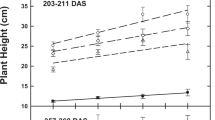Abstract
Nitrogen (N) based secondary metabolite production is thought to be costly to plants because N is required for growth, as well as, the synthesis of these compounds. Therefore, variation in N availability may result in variation in N-based secondary metabolite production. Here, we determine the effect of N fertilization on caffeine (N-based alkaloid) production in coffee (Coffea arabica) seedlings. A growth chamber experiment was performed with three N treatments applied to seedlings. N fertilization increased plant growth, leaf biomass, and plant N. Caffeine concentration in phloem exudates was greater in high-N fertilized plants relative to intermediate- and low-N plants. However, leaf, stem, root, and total overall caffeine concentration and content did not differ across N treatments. These results suggest caffeine in coffee is strongly regulated by genetic factors, and environment is likely less important to caffeine phenotype. This is among the first studies to investigate the effect of N fertilization on caffeine within the phloem, which has important implications for herbivores that are sensitive to caffeine and plant N and feed from the phloem of coffee.

Similar content being viewed by others
References
Araujo WL, Dias PC, Moraes GABK, Celin EF, Cunha RL, Barros RS, DaMatta FM (2008) Limitations to photosynthesis in coffee leaves from different canopy positions. Plant Physiol Biochem 46:884–890
Awmack CS, Leather SR (2002) Host plant quality and fecundity in herbivorous insects. Annu Rev Entomol 47:817–844
Baldwin IT (1998) Jasmonate-induced responses are costly but benefit plants under attack in native populations. Proc Natl Acad Sci USA 95:8113–8118
Bryant JP, Chapin FS III, Klein DR (1983) Carbon/nutrient balance of boreal plants in relation to vertebrate herbivory. Oikos 40:357–368
Coley PD, Bryant JP, Chapin FS (1985) Resource availability and plant antiherbivore defense. Science 230:895–899
Dyer LA, Letourneau DK, Dodson CD, Tobler MA, Stireman JO III, Hsu A (2004) Ecological causes and consequences of variation in defensive chemistry of a Neotropical shrub. Ecology 85:2795–2803
Fernandes FL (2007) Efeito de nitrogênio e de potássio na interação entre Coccus viridis e Coffea arabica. PhD Dissertation, Universidade Federal de Viçosa, Minas Gerais, Brazil
Filho OG, Mazzafera P (2000) Caffeine does not protect coffee against the leaf miner Perileucoptera coffeella. J Chem Ecol 26:1447–1464
Gerson EA, Kelsey RG (1999) Piperidine alkaloids in nitrogen fertilized Pinus ponderosa. J Chem Ecol 25:2027–2039
Givovich A, Sandström J, Niemeyer HM, Pettersson J (1994) Presence of a hydroxamic acid glucoside in wheat phloem sap, and its consequences for performance of Rhopalosiphum padi (L.) (Homoptera: Aphididae). J Chem Ecol 20:1923
Hamilton JG, Zangerl AR, DeLucia EH, Berenbaum MR (2001) The carbon-nutrient balance hypothesis: its rise and fall. Ecol Lett 4:86–95
Herms DA, Mattson WJ Jr (1992) The dilemma of plants: to grow or defend. Q Rev Biol 67:283–335
Hoagland DR, Arnon DI (1950) The water-culture method for growing plants without soil, revised edn. California Agricultural Experimental Station, Berkeley, Circular 347
Höft M, Verpoorte R, Beck E (1996) Growth and alkaloid contents in leaves of Tabernaemontana pachysiphon Stapf (Apocynaceae) as influenced by light intensity, water and nutrient supply. Oecologia 107:160–169
Karban R, Baldwin IT (1997) Induced responses to herbivory. The University of Chicago Press, Chicago
King RW, Zeevaart JAD (1974) Enhancement of phloem exudation from cut petioles by chelating agents. Plant Physiol 53:96–103
Le Pelley RH (1973) Coffee insects. Annu Rev Entomol 18:121–142
Magalhães STV, Guedes RNC, Demuner AJ, Lima ER (2008) Effect of coffee alkaloids and phenolics on egg-laying by the coffee leaf miner Leucoptera coffeella. Bull Entomol Res 98:483–489
Mazzafera P (1999) Mineral nutrition and caffeine content in coffee leaves. Bragantia 58:387–391
Mazzafera P, Gonçalves KV (1999) Nitrogen compounds in the xylem sap of coffee. Phytochemistry 50:383
McKey D (1974) Adaptive patterns in alkaloid physiology. Am Nat 108:305–320
Moguel P, Toledo VM (1999) Biodiversity conservation in traditional coffee systems of Mexico. Conserv Biol 13:11–21
Montagnon C, Guyot B, Cilas C, Leroy T (1998) Genetic parameters of several biochemical compounds from green coffee, Coffea canephora. Plant Breed 117:576–578
Nathanson JA (1984) Caffeine and related methylxanthines: possible naturally occurring pesticides. Science 226:184–187
Palumbo MJ, Putz FE, Talcott ST (2007) Nitrogen fertilizer and gender effects on the secondary metabolism of yaupon, a caffeine-containing North American holly. Oecologia 151:1–9
Perfecto I, Rice RA, Greenberg R, van der Voort ME (1996) Shade coffee: a disappearing refuge for biodiversity. Bioscience 46:598–608
Ponder KL, Pritchard J, Harrington R, Bale JS (2000) Difficulties in location and acceptance of phloem sap combined with reduced concentration of phloem amino acids explain lowered performance of the aphid Rhopalosiphum padi on nitrogen deficient barley (Hordeum vulgare) seedlings. Entomol Exp Appl 97:203–210
van Dam NM, Witte L, Theuring C, Hartmann T (1995) Distribution, biosynthesis and turnover of pyrrolizidine alkaloids in Cynoglossum officinale. Phytochemistry 39:287–292
Zheng XQ, Ashihara H (2004) Distribution, biosynthesis and function of purine and pyridine alkaloids in Coffea arabica seedlings. Plant Sci 166:807–813
Acknowledgments
R. Friedrich, L. Moorhead, C. Murnen, and G. Pardee helped in lab work. J. Frantz and the USDA provided elemental analysis. S. Heckathorn, I. Perfecto, L. Moorhead, K. Ennis, and two anonymous reviewers contributed greatly to the preparation of previous manuscripts. The Plant Science Research Center allowed the use of their facilities. This research was supported by a Sigma Xi Grant-in-Aid of Research, the Society of Integrated and Comparative Biology Grant-in-Aid of Research, the University of Toledo, and USDA grant number 2003-38894-02032.
Author information
Authors and Affiliations
Corresponding author
Rights and permissions
About this article
Cite this article
Gonthier, D.J., Witter, J.D., Spongberg, A.L. et al. Effect of nitrogen fertilization on caffeine production in coffee (Coffea arabica). Chemoecology 21, 123–130 (2011). https://doi.org/10.1007/s00049-011-0073-7
Received:
Accepted:
Published:
Issue Date:
DOI: https://doi.org/10.1007/s00049-011-0073-7




